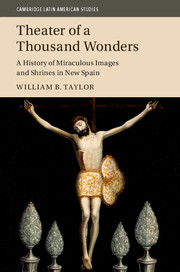Book contents
- Frontmatter
- Dedication
- Contents
- List of Figures
- List of Maps
- List of Tables
- Preface and Acknowledgments
- Archive Abbreviations
- Introduction
- Part I Bearings: Historical Patterns and Places of Image Shrines
- Part II Soundings: Divine Presence, Place, and the Power of Things
- 5 Making Miracles
- 6 Relics, Images, and Other Numinous Things
- 7 Religious Prints and Their Uses
- 8 Placing the Cross in Colonial Mexico
- 9 Pilgrims, Processions, and Romerías
- Conclusion
- Appendix 1 Colonial Image Shrines
- Appendix 2 When Shrines Began
- Appendix 3 Other Saints
- Index
6 - Relics, Images, and Other Numinous Things
from Part II - Soundings: Divine Presence, Place, and the Power of Things
Published online by Cambridge University Press: 05 September 2016
- Frontmatter
- Dedication
- Contents
- List of Figures
- List of Maps
- List of Tables
- Preface and Acknowledgments
- Archive Abbreviations
- Introduction
- Part I Bearings: Historical Patterns and Places of Image Shrines
- Part II Soundings: Divine Presence, Place, and the Power of Things
- 5 Making Miracles
- 6 Relics, Images, and Other Numinous Things
- 7 Religious Prints and Their Uses
- 8 Placing the Cross in Colonial Mexico
- 9 Pilgrims, Processions, and Romerías
- Conclusion
- Appendix 1 Colonial Image Shrines
- Appendix 2 When Shrines Began
- Appendix 3 Other Saints
- Index
Summary
Since Christianity's early years the mystique of divine presence has found expression in sacred things. Beyond the ever-present portability of the consecrated Host, relics come to mind immediately, especially the remains of saints. As Annabel Wharton puts it, the bodies and possessions of saints offer “reassurance that the past retains its authority … A relic is a sign of previous power, real or imagined. It promises to put that power back to work.” Why popular cults and pilgrimages celebrating bone relics did not become more important in New Spain even though thousands of certified remains of saints were brought from Europe is something of a mystery, given the veneration of ancestors and the importance attached to their remains and living presence by precolonial and colonial Mesoamericans, as well as Spaniards’ interest in ancestry and recognized relics. Native Mesoamericans would seem to have been predisposed to see Christian relics as numinous things since the bones of totemic ancestors were regarded as sources of regeneration, protection, and legitimacy, if not as the very bones of the gods. Guilhem Olivier's study of sacred bundles containing bones of the ancestors appearing in precolonial and early colonial depictions of processions and migrations suggests that bones as relics were handled in a manner that would have made Christian relics comprehensible and compelling. As Olivier puts it, these sacred bundles served as “the memory constituting the cohesion of their collective identity at the boundary between the founding myths and the specific migration history of each group.” But few Christian bone relics were made readily available for public adoration, and none was promoted or spontaneously arose as a pilgrimage site. The Third Synod of prelates meeting in 1585 put it bluntly: “[D]o not expose relics of the saints to public veneration.” Granted, colonial laws often bowed to customary practices, and officials learned to make their peace with popular enthusiasms, but bone relics were not often available to the American public in the way images were. Things of the saints and saintly were always treasured, but during the seventeenth and eighteenth centuries they ceded pride of place as relics to images in the material culture of divine immanence.
- Type
- Chapter
- Information
- Theater of a Thousand WondersA History of Miraculous Images and Shrines in New Spain, pp. 361 - 397Publisher: Cambridge University PressPrint publication year: 2016
- 1
- Cited by

